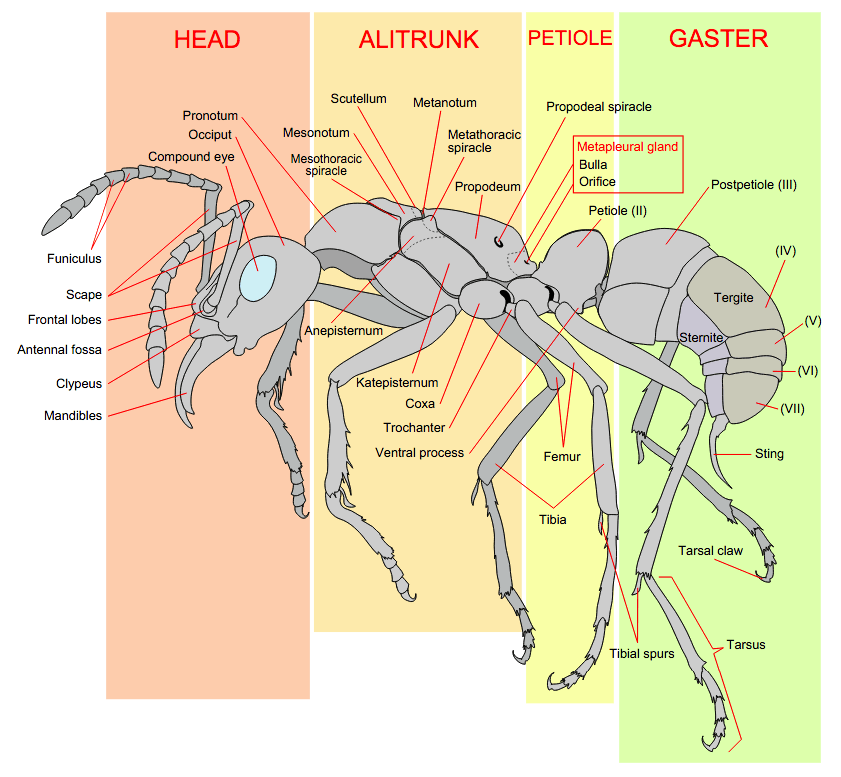GET A FREE QUOTE TODAY - CALL US (573) 874-5100
BLACK ANTS
Ants are social insects of the family Formicidae and, along with the related wasps and bees, belong to the order Hymenoptera. Ants evolved from wasp-like ancestors in the mid-Cretaceous period between 110 and 130 million years ago and diversified after the rise of flowering plants. More than 12,500 out of an estimated total of 22,000 species have been classified. They are easily identified by their elbowed antennae and a distinctive node-like structure that forms a slender waist.
Ants form colonies that range in size from a few dozen predatory individuals living in small natural cavities to highly organised colonies which may occupy large territories and consist of millions of individuals. These larger colonies consist mostly of sterile wingless females forming castes of “workers”, “soldiers”, or other specialised groups. Nearly all ant colonies also have some fertile males called “drones” and one or more fertile females called “queens.” The colonies are sometimes described as superorganisms because the ants appear to operate as a unified entity, collectively working together to support the colony.
Ants have colonised almost every landmass on Earth. The only places lacking indigenous ants are Antarctica and a few remote or inhospitable islands. Ants thrive in most ecosystems, and may form 15-25% of the terrestrial animal biomass. Their success in so many environments has been attributed to their social organisation and their ability to modify habitats, tap resources, and defend themselves. Their long co-evolution with other species has led to mimetic, commensal, parasitic, and mutualistic relationships.
Ant societies have division of labour, communication between individuals, and an ability to solve complex problems. These parallels with human societies have long been an inspiration and subject of study.
Many human cultures make use of ants in cuisine, medication and rituals. Some species are valued in their role as biological pest control agents. However, their ability to exploit resources brings ants into conflict with humans, as they can damage crops and invade buildings. Some species, such as the red imported fire ant, are regarded as invasive species, establishing themselves in areas where they are accidentally introduced.
Ants are distinct in their morphology from other insects in having elbowed antennae, metapleural glands, and a strong constriction of their second abdominal segment into a node-like petiole. The head, mesosoma and metasoma or gaster are the three distinct body segments. The petiole forms a narrow waist between their mesosoma (thorax plus the first abdominal segment, which is fused to it) and gaster (abdomen less the abdominal segments in the petiole). The petiole can be formed by one or two nodes (the second alone, or the second and third abdominal segments).
Like other insects, ants have an exoskeleton, an external covering that provides a protective casing around the body and a point of attachment for muscles, in contrast to the internal skeletons of humans and other vertebrates. Insects do not have lungs; oxygen and other gases like carbon dioxide pass through their exoskeleton through tiny valves called spiracles. Insects also lack closed blood vessels; instead, they have a long, thin, perforated tube along the top of the body (called the “dorsal aorta”) that functions like a heart, and pumps haemolymph towards the head, thus driving the circulation of the internal fluids. The nervous system consists of a ventral nerve cord that runs the length of the body, with several ganglia and branches along the way reaching into the extremities of the appendages.
An ant’s head contains many sensory organs. Like most insects, ants have compound eyes made from numerous tiny lenses attached together. Ants’ eyes are good for acute movement detection but do not give a high resolution. They also have three small ocelli (simple eyes) on the top of the head that detect light levels and polarization. Compared to vertebrates, most ants have poor-to-mediocre eyesight and a few subterranean species are completely blind. Some ants such as Australia’s bulldog ant, however, have exceptional vision. Two antennae (“feelers”) are attached to the head; these organs detect chemicals, air currents and vibrations; they are also used to transmit and receive signals through touch. The head has two strong jaws, the mandibles, used to carry food, manipulate objects, construct nests, and for defence. In some species a small pocket (infrabuccal chamber) inside the mouth stores food, so it can be passed to other ants or their larvae. All six legs are attached to the mesosoma (“thorax”). A hooked claw at the end of each leg helps ants to climb and hang onto surfaces. Most queens and male ants have wings; queens shed the wings after the nuptial flight, leaving visible stubs, a distinguishing feature of queens. However, wingless queens (ergatides) and males occur in a few species.
The metasoma (the “abdomen”) of the ant houses important internal organs, including those of the reproductive, respiratory (tracheae) and excretory systems. Workers of many species have their egg-laying structures modified into stings that are used for subduing prey and defending their nests.

